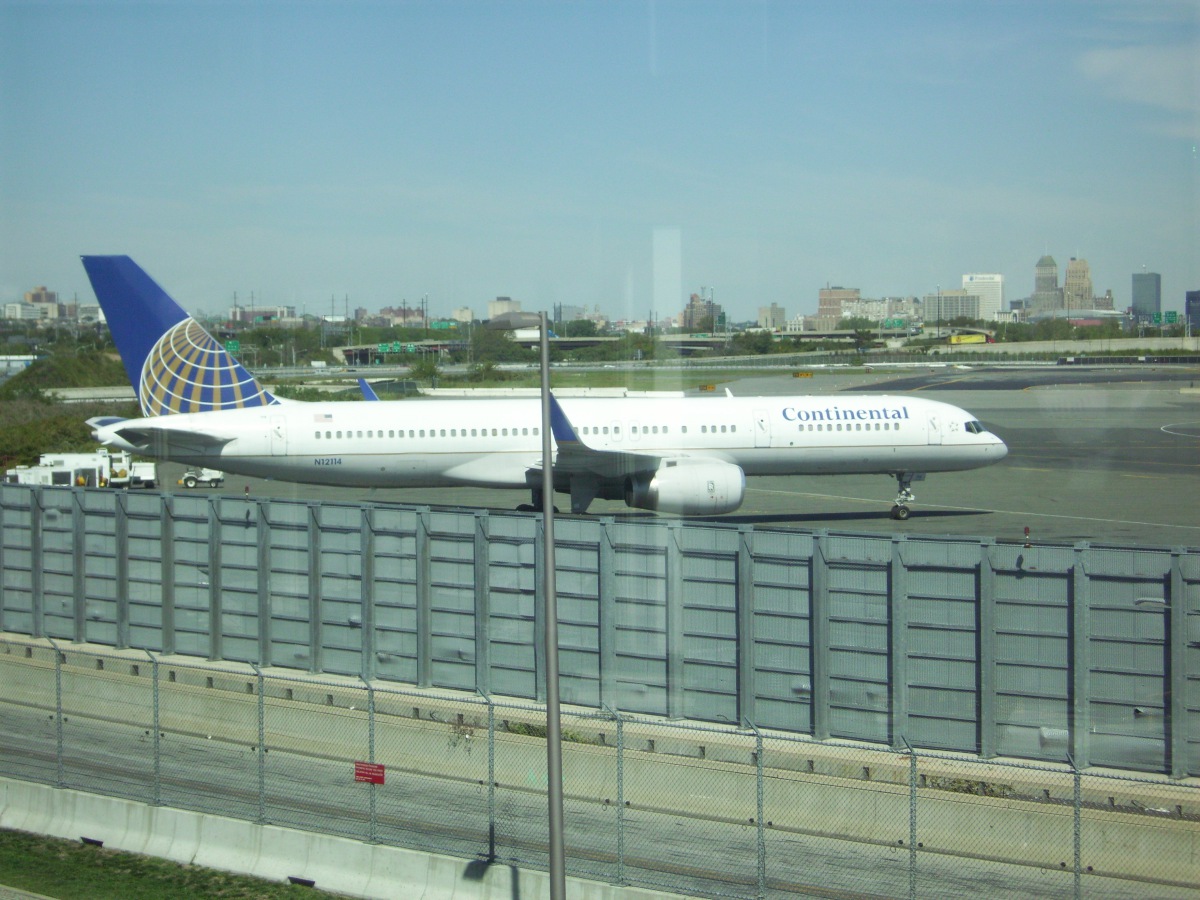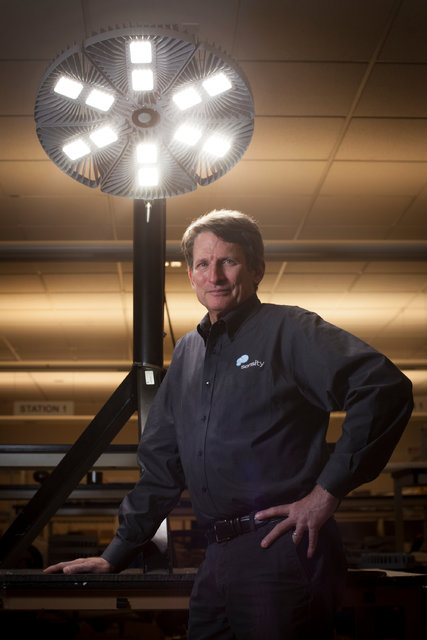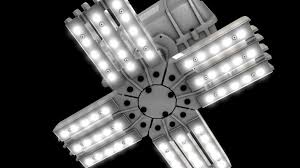LED lamps will follow the visitors of Newark Airport.
With a US headquarters, our team became interested in the news from Newark International Airport. Newark, located within the cities of Newark and Elizabeth (New Jersey) Airport, is located 24 kilometers south-west of the New York area of Midtown. Nyarka is the second largest airport after Houston Intercontinental Airport Continental Airlines.
And today, visitors to Terminal B at Newark Liberty International Airport may notice bright, clean lighting, the interior of the airport has recently been supplemented with 171 LED lamps. But visitors, most likely, will not understand that these lamps are the basis of the system that is watching them.

')
An array of sensors and eight video cameras are used throughout the terminal, and the lamps are part of a new wireless network that collects and transmits data to software that can recognize long lines, license plates and even detect suspicious activities by sending alerts to relevant personnel.
The project is still in its early stages, but New York and New Jersey port control officers who work at the airport are already talking about expanding the project to other terminals and buildings.
The system promises improved security management, as well as energy, movement and flow of people. But on the other hand, according to advocates of confidentiality, the threat of using this technology is increasing due to the risk of invasion of privacy, due to the abuse of this information. Fred H. Keith, director of the Center for Applied Cybersecurity Research at Indiana University, described the potential for abuse in one word - “scary”. He does not worry about the technology itself, the reason for its concern is the process of its use. According to him, it is very important to select data that will actually be useful and how to properly manage this process.
At Newark Airport, PortNadzor will own the data that it collects and it will maintain it. Currently, no other agencies have access to them, and law enforcement agencies can only get it through a court or a written request.
Also, the fact that the system is viewed as a way to help the government and private companies save energy, automatically turn the lights on and off, has expanded the lighting, sensor and software markets that can intercept and analyze a huge amount of data on the habits of ordinary citizens.

The luminaires are equipped with special chips and are connected to sensors, cameras and among themselves wirelessly. Data can be collected and analyzed for a wide range of applications. Systems such as the security system of port surveillance, developed by a company called Sensity Systems, may soon be more widespread. According to recent agreements, Amerlux, a leading manufacturer of lighting products, will begin to use technology in its LED lamps.
“We are discovering a completely new area of lighting applications and services,” said Chuck Kampagna, Chief Executive Officer of Amerlux, “including video-based security and public order, parking management, preventive maintenance, and more.”
Other companies, including such giants as Cisco Systems and Philips, are racing this technology to capture market share. Las Vegas is testing a street lighting system that can broadcast sound, and plans to use it mainly to control the lighting and turn on the music or issue warnings by the security system on the pedestrian zone.
Copenhagen has 20,000 streetlights installed within a system that can ultimately control movement, monitor carbon dioxide levels and determine when trash cans are full. Other government agencies and businesses have begun to replace thousands of lamps with LEDs, mainly to reduce their costs.
The trend is expected to accelerate soon as the fixtures become cheaper, cheaper and more sophisticated. Navigant Consulting, a Chicago-based firm, believes that cities will be more interested in the more than $ 100 billion in technology spending over the next 10 years.
“More and more decisions are being made in favor of networked lighting control, not only for energy advantages, but also for a range of non-energy needs,” said Jesse Foote, an analyst with the lighting industry at Navigant.
Sensity technology, for example, will allow light fixtures and sensors to pinpoint a shot, sense an earthquake or dangerous gas, or find someone who stops at various car parks.
“We see outdoor lighting as the ideal infrastructure for creating a brand new network,” said Hugh Martin, CEO of Sensity.


But privacy advocates are concerned that this network can be used to gather private information about people and the planet. There are people in the commercial space who want to collect everything, keep all the information around them forever and are ready to pay for it. “I’m not saying that I know the exact balance point of using this technology, but technology has great value, and I think we’ll do everything right with this information,” said Hugh Martin. His company has a council that includes Heather Zichal, a former adviser to President Obama on energy and climate change issues, and a former Rep. Richard A. Jeffardt to help figure out the implications of the technology. “I just think that we have to be very thoughtful when talking about the positive and negative sides of this technology,” said Hugh Martin.
In general, the potential for “advanced” lighting is almost endless. “Nobody wanted a smartphone 20 years ago because they didn’t know they could have one,” said Fred Maksik, founder and chief technology officer of the Lighting Science Group, which produces LEDs. "And I think the same thing with the lighting today: no one knows what the lighting will be capable of."
And today, visitors to Terminal B at Newark Liberty International Airport may notice bright, clean lighting, the interior of the airport has recently been supplemented with 171 LED lamps. But visitors, most likely, will not understand that these lamps are the basis of the system that is watching them.

')
An array of sensors and eight video cameras are used throughout the terminal, and the lamps are part of a new wireless network that collects and transmits data to software that can recognize long lines, license plates and even detect suspicious activities by sending alerts to relevant personnel.
The project is still in its early stages, but New York and New Jersey port control officers who work at the airport are already talking about expanding the project to other terminals and buildings.
The system promises improved security management, as well as energy, movement and flow of people. But on the other hand, according to advocates of confidentiality, the threat of using this technology is increasing due to the risk of invasion of privacy, due to the abuse of this information. Fred H. Keith, director of the Center for Applied Cybersecurity Research at Indiana University, described the potential for abuse in one word - “scary”. He does not worry about the technology itself, the reason for its concern is the process of its use. According to him, it is very important to select data that will actually be useful and how to properly manage this process.
At Newark Airport, PortNadzor will own the data that it collects and it will maintain it. Currently, no other agencies have access to them, and law enforcement agencies can only get it through a court or a written request.
Also, the fact that the system is viewed as a way to help the government and private companies save energy, automatically turn the lights on and off, has expanded the lighting, sensor and software markets that can intercept and analyze a huge amount of data on the habits of ordinary citizens.

The luminaires are equipped with special chips and are connected to sensors, cameras and among themselves wirelessly. Data can be collected and analyzed for a wide range of applications. Systems such as the security system of port surveillance, developed by a company called Sensity Systems, may soon be more widespread. According to recent agreements, Amerlux, a leading manufacturer of lighting products, will begin to use technology in its LED lamps.
“We are discovering a completely new area of lighting applications and services,” said Chuck Kampagna, Chief Executive Officer of Amerlux, “including video-based security and public order, parking management, preventive maintenance, and more.”
Other companies, including such giants as Cisco Systems and Philips, are racing this technology to capture market share. Las Vegas is testing a street lighting system that can broadcast sound, and plans to use it mainly to control the lighting and turn on the music or issue warnings by the security system on the pedestrian zone.
Copenhagen has 20,000 streetlights installed within a system that can ultimately control movement, monitor carbon dioxide levels and determine when trash cans are full. Other government agencies and businesses have begun to replace thousands of lamps with LEDs, mainly to reduce their costs.
The trend is expected to accelerate soon as the fixtures become cheaper, cheaper and more sophisticated. Navigant Consulting, a Chicago-based firm, believes that cities will be more interested in the more than $ 100 billion in technology spending over the next 10 years.
“More and more decisions are being made in favor of networked lighting control, not only for energy advantages, but also for a range of non-energy needs,” said Jesse Foote, an analyst with the lighting industry at Navigant.
Sensity technology, for example, will allow light fixtures and sensors to pinpoint a shot, sense an earthquake or dangerous gas, or find someone who stops at various car parks.
“We see outdoor lighting as the ideal infrastructure for creating a brand new network,” said Hugh Martin, CEO of Sensity.


But privacy advocates are concerned that this network can be used to gather private information about people and the planet. There are people in the commercial space who want to collect everything, keep all the information around them forever and are ready to pay for it. “I’m not saying that I know the exact balance point of using this technology, but technology has great value, and I think we’ll do everything right with this information,” said Hugh Martin. His company has a council that includes Heather Zichal, a former adviser to President Obama on energy and climate change issues, and a former Rep. Richard A. Jeffardt to help figure out the implications of the technology. “I just think that we have to be very thoughtful when talking about the positive and negative sides of this technology,” said Hugh Martin.
In general, the potential for “advanced” lighting is almost endless. “Nobody wanted a smartphone 20 years ago because they didn’t know they could have one,” said Fred Maksik, founder and chief technology officer of the Lighting Science Group, which produces LEDs. "And I think the same thing with the lighting today: no one knows what the lighting will be capable of."
Source: https://habr.com/ru/post/213355/
All Articles